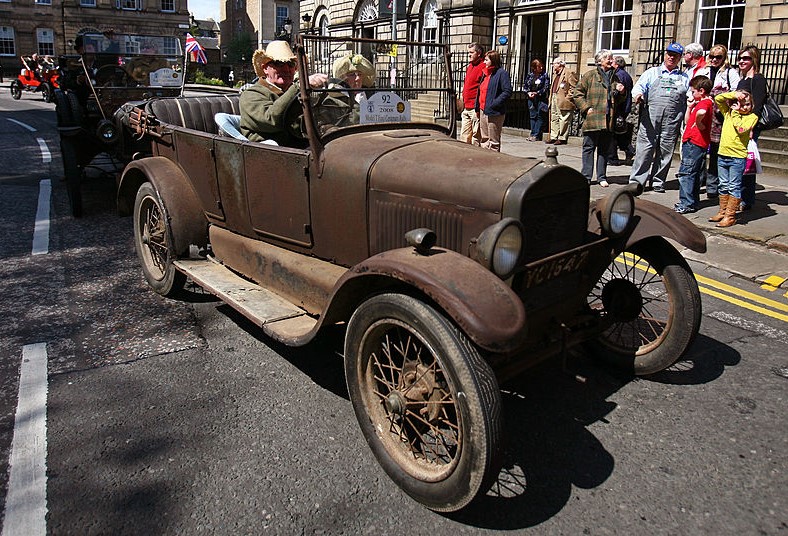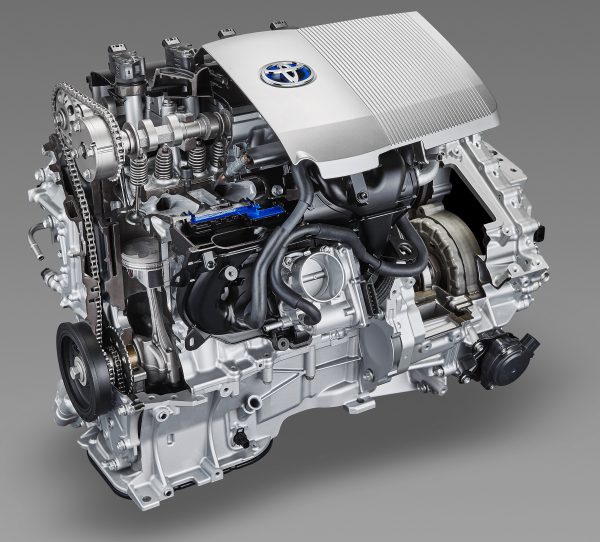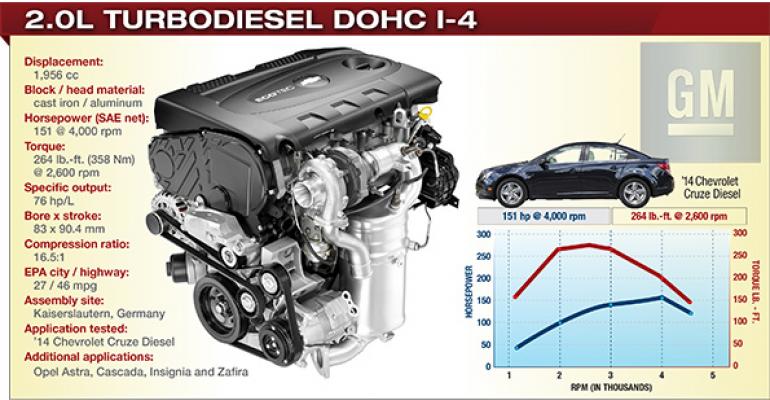This is the sixth and final article in a series highlighting powertrain trends as the Wards 10 Best Engines competition celebrates its 25th year.
The inline 4-cyl. engine’s first patron, German Wilhelm Maybach, was heralded by the French as the “King of (car) Designers.”
After inventing a practical petroleum-fueled single-cylinder engine in 1885 for seminal motorcycle, motorboat and airship applications, Maybach and his partner Gottlieb Daimler created the first I-4 in 1894 to power their Phoenix automobile.
Design features included a vertically oriented block of cylinders, a carburetor mixing air with evaporated gasoline and a camshaft to open the exhaust valves.
Imitators followed suit because the I-4 was much smoother and more powerful than turn-of-the-century single-, twin-, and three-cylinder alternatives.
Casting the crankcases of aluminum saved weight, while early iron blocks were integrated with their heads for simplicity.
Large crankshaft counterweights were unnecessary with two pistons rising while two others descended. One power pulse every half turn of the crank was smooth enough in early low-speed engines.
By 1911, Fiat had increased I-4 displacement to an awesome 28.3L for racing, yielding more than 250 hp at only 1,500 rpm.
Two years later, the brilliant Swiss designer Ernst Henry topped an I-4 with the first dual- overhead camshaft 4-valve cylinder head, allowing Jules Goux to win the Indy 500 with ease in his Peugeot.
Success at Brickyard
Duly inspired, Americans Henry Miller, Fred Offenhauser and John Edwards designed the better I-4 mousetrap which would succeed at the Brickyard from 1922 (first victory) through 1980 (15% of the starting field with a third-place finish).
In 1935, 1938, 1949-50, 1952-56, 1959-60, 1962 and 1964, every car that started this 500-mile (805-km) race was a Miller/Offenhauser. All told, this I-4 family won an incredible 39 Indy 500s.
The I-4’s Formula One heyday came in the 1980s when aggressively turbocharged BMW 1.5L engines produced 1,300 hp for qualifying and 600-700 hp for the race.
In production cars, Henry Ford’s remarkable Model T arrived in 1908 with a 2.9L I-4 producing 20 hp. To minimize cost and simplify service, the 20th century’s most influential car had no water, oil or fuel pump. More than 15 million Ford Model Ts were sold over two decades.
And where would allied soldiers have been without the I-4-powered Jeeps produced by Ford and Willys for World War II? The 60-hp Go Devil engine designed by Willys had the strength and stamina needed to win the day. More than 640,000 were built, many of which are still thumping in surviving Jeeps.

Vintage Model T's parade through Edinburgh, Scotland, in 2008 to mark 100-year anniversary of car's arrival.
Problems Arise
The I-4’s most obvious flaw is its second-order (twice crank speed) vertical shaking caused by piston acceleration that’s greater at the top than at the bottom of the stroke.
In 1911, Dr. Fredrick Lanchester patented a solution: a pair of balance shafts mounted parallel longitudinally rotating in opposite directions at twice crankshaft speed.
In 1975, when larger, faster-running I-4s were prominent, Mitsubishi invented a more effective vibration fix: balance shafts located at different heights to placate both the vertical shaking and the rocking couple (back and forth motion about the crankshaft).
Licenses to the technology were sold and several makers added the Mitsubishi Silent Shafts to their I-4s instead of upgrading to V-6s or V-8s.
For the ’13 model year, GM integrated balance shafts with the oil pump, tucking that assembly low in its 2.5L LCV I-4, which revved smoothly to 7,000 rpm.
One of the more interesting stretches of the I-4’s wings arrived in ’19 with assignments powering Chevrolet’s Silverado and GMC’s Sierra 1500-series pickups. GM’s turbocharged 2.7L L3B I-4 produces a meaty 310 horsepower, trumping the fullsize trucks’ 4.3L V-6 and 3.0L turbodiesel I-6 alternatives.
Award Winners
Four-cyl. engines have been a fixture since the inaugural year of the Wards 10 Best Engines competition in 1995.
The two winners in that first year were Honda’s 2.2L VTEC variable valve-timing engine in the beloved Prelude and Saab’s 2.3L LPT engine powering that brand’s flagship 9000 CS sedan. Both of those I-4s enjoyed a two-year stay on the list.
Two more I-4s joined this exclusive club in 1997: Audi’s turbocharged 1.8L from the A4 sedan and VW’s 1.9L Passat TDI turbodiesel. (This oil burner existed well before VW’s Dieselgate scandal.)
In 1998, VW’s gasoline engine-design aptitude was recognized for the venerable 1.8L TSI turbocharged DOHC powerplant which gained subsequent trophies in 2002, 2003, 2014 and 2015.
While 1999 was a bye year, the I-4 roared back in 2000 with Acura’s 2.0L DOHC powering the RSX Type S. Editors were so impressed by that I-4 that it also earned 10 Best recognition in the succeeding three years (2001-03).
The hybrid era began in 2001 with a victory by the Toyota Prius powered (mostly) by a 1.5L DOHC fuel burner; it returned to the list in 2004. Upgraded to 1.8L, the Prius powertrain won again in 2010 and 2016 (pictured below).
BMW’s first I-4 recognition arrived in 2003 for the supercharged 1.6L SOHC engine that energized the Mini Cooper S.

Floodgates Open in 2006
Following an I-4 bye in 2005, this engine configuration scored three trophies in 2006: for Audi’s turbo 2.0L TFSI (which also won four more years in a row); the MazdaSpeed3’s turbo 2.3L DOHC DISI (return winner in 2007 and 2008); and Chevy’s supercharged 2.0L DOHC LSJ in the spunky Cobalt SS.
While the VW Jetta TDI turbodiesel won three years beginning in 2009, those awards were subsequently rescinded for (Dieselgate) misbehavior. Chevy’s Equinox earned the nod in 2010 for its DOHC 2.4L Ecotec LAF engine.
In 2011, Chevy’s ambitious Volt plug-in hybrid earned recognition with its range-extending gasoline-electric propulsion system. The next-gen Volt powertrain would return in 2016 and 2017.
The BMW-Mini’s switch from supercharging to turbocharging won it another berth in 2011 with a DOHC 1.6L employing direct fuel injection.
BMW again made the list in 2012 (with a 2013 follow up) for its N20 powering the 328i coupe and sedan. Add to that Ford’s EcoBoost from the Focus ST and Taurus and the LTG from the Cadillac ATS.
All three were turbocharged DOHC 2.0L designs earning a two-year run. In addition, Hyundai received kudos for the Accent’s DOHC 1.6L, and Mazda again made the list with its Skyactiv 2.0L.
In 2014, a 2.0L LUZ turbodiesel prevailed under the hood of Chevy’s Cruze (see infographic below). In addition to previously mentioned 2016 winners, Hyundai won with its plug-in hybrid Sonata, and Volvo began a two-year run with its turbocharged and supercharged DOHC 2.0L prime mover.
In 2017, the Honda Accord hybrid’s 2.0L cleverly combined an Atkinson cycle with VTEC technology to win recognition along with Hyundai for its Elantra Eco’s turbocharged DOHC 1.4L and Mazda’s turbocharged DOHC 2.5L CX-9 crossover engine.
There were three 2018 I-4 winners: the Honda Civic Type R’s turbocharged DOHC 2.0L with VTEC, the Jaguar XF’s turbocharged DOHC 2.0L and the Toyota Camry Hybrid’s DOHC 2.5L running the Atkinson cycle.
In 2019, the Honda Accord Hybrid (present in 2017) was back again, along with the Nissan-Infiniti’s DOHC VC-Turbo 2.0L powering the QX50 and the Toyota-Lexus UX 250 hybrid’s DOHC 2.0L Atkinson-cycle engine.
The clear pattern is that I-4’s thrive with advanced valvetrain and fuel-delivery technology and boosting – turbos, superchargers or, in Volvo’s case, both types of blowers. They team well with electric motors in hybrid and plug-in hybrid applications. With simple balance shaft remedies, I-4s can be impeccably smooth at high rpm.
During 10 Best Engines’ quarter-century run, I-4s appeared 66 times, finishing second overall behind the 6-cyl. (114 wins) and ahead of the V-8 (53 wins).
So, when the debate turns to powerplants, no vehicle engineer should hesitate assigning a thoughtfully designed I-4 to the task.






